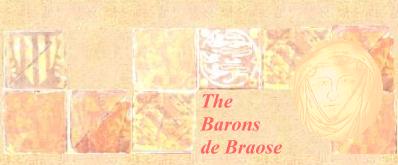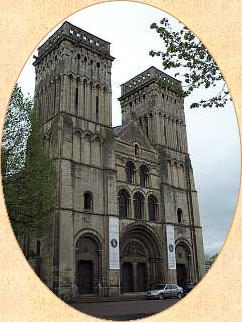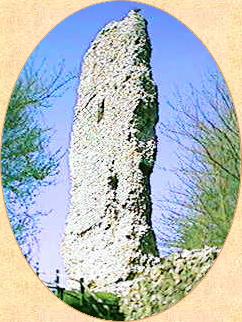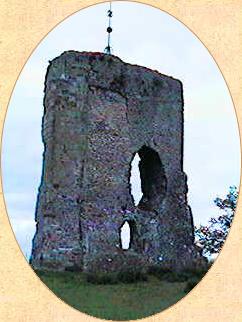
Lord
of the Rape

William de Braose sailed
to England with William the Conqueror in 1066 (2.1)
His home was Briouze in Normandy, near Falaise where the Conqueror
was born. He held other lands including Guibray at Falaise, where
one of the greatest trading fairs of Normandy took place.
The
de Braose family origins are unknown, except for the name of
William's mother Gunnor.(2.2) She became a nun at the Abbey
of Holy Trinity in Caen, known as the Abbaye aux Dames . Like Queen Matilda who founded the abbey, Gunnor
was probably buried there.
King William distributed
manors across the country to his companions but he chose his
best warriors to defend the coast of Sussex. Trade and travel
between Sussex and Normandy was a lifeline for the new conquerors.
Sussex was divided into
"rapes" for administrative and defensive purposes.
The King created a lordship for each rape and the lord strengthened
his position by developing a major castle and a port. Trade with
Normandy soon flourished, free from interference by English rebels
or invaders such as the French or the Danes.
 William
de Braose became Lord of the Rape of Bramber five or six years
after the Conquest. He also gained some manors elsewhere,
including important locations around Wareham in Dorset. In Sussex,
de Braose's rape straddled the River Adur. It was carved out
of the lands between his two Norman neighbours, William de Warenne,
the Lord of Lewes Rape and Roger de Montgomery, Lord of Arundel
Rape. (2.3)
William
de Braose became Lord of the Rape of Bramber five or six years
after the Conquest. He also gained some manors elsewhere,
including important locations around Wareham in Dorset. In Sussex,
de Braose's rape straddled the River Adur. It was carved out
of the lands between his two Norman neighbours, William de Warenne,
the Lord of Lewes Rape and Roger de Montgomery, Lord of Arundel
Rape. (2.3)
William
de Braose had built Bramber
Castle, near Steyning,
by 1073 to dominate the fertile Adur River Valley and its coast.
At first the castle would have been a ditch and a wooden enclosure
with a high defensive mound inside. Stone castles were only started
after local resistance was under firm control.
The
rape needed inland defences so William built Knepp Castle,
near Shipley. It became a hunting lodge favoured by generations
of de Braoses and even by King John when he briefly held the
castle. A mound and some flint ruins can still be seen. Shipley
Church has survived with many Norman features intact.
 Links
between Bramber and Normandy existed before the Conquest. These
became highly sensitive after 1066 and were destined to cause
some serious problems for William de Braose.
Links
between Bramber and Normandy existed before the Conquest. These
became highly sensitive after 1066 and were destined to cause
some serious problems for William de Braose.
The River Adur was wider
and deeper than it is today and it had a thriving port at Steyning,
just north of Bramber Castle. The port belonged to an important
Saxon church, Saint Cuthman's. King Æthelwulf was originally
buried there in 858. In 1043 Edward the Confessor granted Saint
Cuthman's Church to the Benedictine Abbey of Fécamp in
Normandy. The monks of Fécamp had given Edward refuge during his long period of exile
in Normandy. Later, as King of England, Edward rewarded their
hospitality. The port was significantly placed on a navigable
river and seemed to represent an "open door" for a
Norman successor to King Edward, who was childless.
King Harold's father was a dominant force during Edward's reign. He severed
the link between Saint Cuthman's and Fécamp in his efforts
to check the Norman influence on English affairs. Harold continued this policy before and after his coronation. William the
Conqueror cited this outrage as one of the reasons for his invasion
and Fécamp Abbey lent its powerful moral support. The
Norman attack and William's claim to the throne won the Pope's
blessing and the status of a holy war or crusade. Benedictine monks
from Fécamp funded an invading ship and followed the Conqueror to Hastings, in anticipation
of lavish endowments and special favour. (2.4)
William de Braose had other
priorities. He was intent on building the defences of his rape
and placing his own men at key locations. (2.5)
He paid little attention to the monks at Steyning. The King also
seemed to have forgotten his earlier promises to Fécamp
when he established the new lordship at Bramber Castle. Fécamp
Abbey nursed its claims until twenty years after the Conquest,
when the issues were put to the test.

back to text

back to text

back to text
William de Braose sailed to England with William the Conqueror in 1066 (2.1) His home was Briouze in Normandy, near Falaise where the Conqueror was born. He held other lands including Guibray at Falaise, where one of the greatest trading fairs of Normandy took place. The de Braose family origins are unknown, except for the name of William's mother Gunnor.(2.2) She became a nun at the Abbey of Holy Trinity in Caen, known as the Abbaye aux Dames . Like Queen Matilda who founded the abbey, Gunnor was probably buried there. King William distributed manors across the country to his companions but he chose his best warriors to defend the coast of Sussex. Trade and travel between Sussex and Normandy was a lifeline for the new conquerors. Sussex was divided into "rapes" for administrative and defensive purposes. The King created a lordship for each rape and the lord strengthened his position by developing a major castle and a port. Trade with Normandy soon flourished, free from interference by English rebels or invaders such as the French or the Danes.
William de Braose had built Bramber Castle, near Steyning, by 1073 to dominate the fertile Adur River Valley and its coast. At first the castle would have been a ditch and a wooden enclosure with a high defensive mound inside. Stone castles were only started after local resistance was under firm control. The rape needed inland defences so William built Knepp Castle, near Shipley. It became a hunting lodge favoured by generations of de Braoses and even by King John when he briefly held the castle. A mound and some flint ruins can still be seen. Shipley Church has survived with many Norman features intact.
The River Adur was wider and deeper than it is today and it had a thriving port at Steyning, just north of Bramber Castle. The port belonged to an important Saxon church, Saint Cuthman's. King Æthelwulf was originally buried there in 858. In 1043 Edward the Confessor granted Saint Cuthman's Church to the Benedictine Abbey of Fécamp in Normandy. The monks of Fécamp had given Edward refuge during his long period of exile in Normandy. Later, as King of England, Edward rewarded their hospitality. The port was significantly placed on a navigable river and seemed to represent an "open door" for a Norman successor to King Edward, who was childless. King Harold's father was a dominant force during Edward's reign. He severed the link between Saint Cuthman's and Fécamp in his efforts to check the Norman influence on English affairs. Harold continued this policy before and after his coronation. William the Conqueror cited this outrage as one of the reasons for his invasion and Fécamp Abbey lent its powerful moral support. The Norman attack and William's claim to the throne won the Pope's blessing and the status of a holy war or crusade. Benedictine monks from Fécamp funded an invading ship and followed the Conqueror to Hastings, in anticipation of lavish endowments and special favour. (2.4) William de Braose had other
priorities. He was intent on building the defences of his rape
and placing his own men at key locations. (2.5)
He paid little attention to the monks at Steyning. The King also
seemed to have forgotten his earlier promises to Fécamp
when he established the new lordship at Bramber Castle. Fécamp
Abbey nursed its claims until twenty years after the Conquest,
when the issues were put to the test.
|
||||||